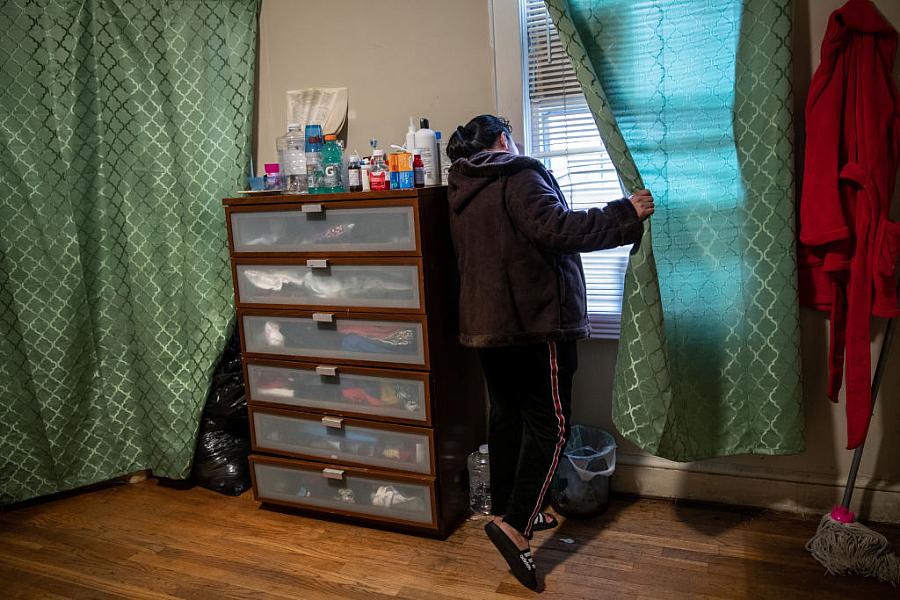In a country plagued by COVID-19, low-income immigrants struggle in the shadows

(Photo by John Moore/Getty Images)
Even before the COVID-19 pandemic, accessing health care in the U.S. has been a challenge for low-income immigrant communities, both legal and undocumented. Barriers include language, lack of information to navigate an unfamiliar and complex health care system, lack of health insurance, and fear of detection by immigration authorities. They’re also likely to receive lower-quality care.
COVID-19 exacerbated these barriers and revealed deep-seated inequities in America’s health care system. That’s despite the fact that since March 27, 2020, the Coronavirus Aid, Relief, and Economic Security (CARES) Act covered testing and treatment for uninsured people.
“For so many immigrants, survival relies on living in the shadows,” says Kathleen Page, an infectious diseases physician at Johns Hopkins University School of Medicine. “Access to care and trust in the medical system are issues that are systemic and haven’t changed.”
I’m interested in understanding the unique challenges low-income immigrants experienced while seeking treatment for COVID-19. I’m also keen to document measures that might have alleviated those challenges and lessons learned along the way, which can be carried forward to better the lives of those often excluded from care.
Immigrants comprise nearly 14% of the U.S. population, of which about 3% are undocumented. Low-income immigrants, particularly those who are undocumented, avoid accessing the health care system unless they have to. Many don’t have health insurance and disproportionately depend on the emergency department. ER care can be extremely expensive, adding anxiety around their immigrant status that can contribute toward decisions about visiting a hospital. Delaying care is a common outcome.
Unfortunately, that remained true even during the COVID-19 pandemic as well. Given the jobs many held, which didn’t allow them to work from home, and crowded living situations, low-income immigrant families were already running a greater risk of getting COVID-19. Landing in hospitals with an escalated infection increased their chances of serious disease and death, which perhaps could have been avoided if they were able to seek early care.
In hospitals, language barriers added to the burden of navigating a COVID-1D infection.
Sixty million people living in the U.S. have a primary language other than English, 24 million of which have limited English language proficiency. Although federal law requires hospitals to offer qualified interpreters, health care providers sometimes rely on bilingual family members accompanying the patient to help with translation. That wasn’t an option as the COVID-19 pandemic raged and infected individuals navigated care in isolation.
When interpreter services were available, although overwhelmed by the surge in patients who spoke little English, they were sometimes limited in their ability to pick up cultural nuance, especially when navigating sensitive conversations about end-of-life concerns and decisions.
“These are already complex conversations,” Page said. “Communications through all translation were really hard. It was heartbreaking.”
Through my reporting, supported by the 2022 Impact Fund for Reporting on Health Equity and Health Systems, I hope to understand how and to what extent perceived health care costs, lack of insurance, language barriers, along with distrust and unfamiliarity with the medical system contributed to immigrant communities’ access to quality COVID-19 care. My goal is to make sense of where the health care system failed them and could improve.
Those lessons may be especially important in the context of those navigating long-term complications that can follow COVID-19 infections. Emerging research indicates that regardless of severity, one in four COVID-19 patients are likely to develop long COVID. From fatigue, shortness of breath, chest, joint and muscle pain to an irregular heart rate, memory, concentration, sleep and mental health conditions, several patients may need continued care.
It’s likely that low-income and under and uninsured immigrant long COVID sufferers may forgo routine checkups and treatments due to the expenses they’d incur and, for those who are undocumented, the fear of getting detected by immigration authorities. This could worsen their health.
I’ll be speaking with long COVID immigrant patients who are struggling to get the care they need in the backdrop of our overall health care system that’s still coming to terms with recognizing and treating long COVID.
In covering their stories, I’ll be looking for interventions that worked or failed. These include examples of generating and disseminating information and tackling misinformation, community engagement, diversity in the health care field, the role of interpreters, and resources to help low-income immigrants trust and navigate the complicated U.S. health care system.

